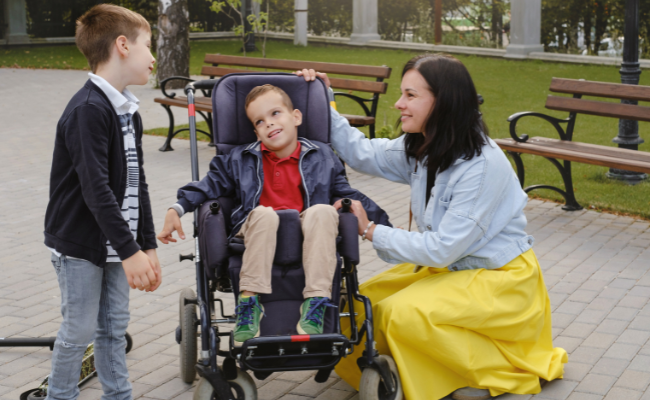How to Treat Cerebral Palsy?
- January 10, 2024
- No Comments

What is Cerebral Palsy?
Cerebral Palsy (CP) is a neurological disorder characterized by issues affecting body movement, muscle coordination, muscle tone, posture, and potential movement disorders. It is a result of damage to the developing brain, occurring frequently before or during birth. The condition exhibits unique manifestations in each individual, ranging from mild to severe impairments in motor skills, muscle tone, and posture, with challenges extending to difficulties in walking, speaking, and performing daily activities.
The impact of CP primarily disrupts the control of muscle movement, categorizing it as a movement disorder. While it may also exert influence on neighboring brain areas and their associated functions, this aspect is not consistently observed. It's crucial to highlight that CP does not inherently lead to intellectual disability. The effects of CP are diverse, and its presentation varies individually, contributing to the complexity of this neurological condition with differing degrees of severity.
Why is Treatment for Cerebral Palsy Necessary?
Treatment for cerebral palsy is crucial because it aims to alleviate symptoms, improve functional abilities, and enhance the overall quality of life for individuals affected by the condition. Since cerebral palsy is a lifelong condition, early intervention and ongoing management are essential to help individuals achieve their maximum potential and lead fulfilling lives.
How to Treat Cerebral Palsy?
- Physical Therapy: Physical therapy is a cornerstone in the treatment of cerebral palsy. It focuses on improving motor skills, muscle strength, and flexibility. Therapists work with individuals to enhance their balance and coordination, making daily activities more manageable. Exercises are tailored to address specific motor challenges, helping individuals gain better control over their movements.
- Occupational Therapy: Occupational therapy aims to improve an individual's ability to perform daily tasks, such as dressing, eating, and writing. Therapists work on developing fine motor skills and cognitive abilities to enhance independence. Adaptive techniques and tools may be introduced to facilitate easier participation in daily activities.
- Speech Therapy: Many individuals with cerebral palsy may face challenges related to speech and communication. Speech therapy addresses these issues by focusing on improving oral motor skills, language development, and communication strategies. Therapists work with individuals to enhance their ability to express themselves effectively.
- Medications: While there is no cure for cerebral palsy, medications may be prescribed to manage specific symptoms. Muscle relaxants can help reduce spasticity, while other medications may address pain, seizures, or associated conditions. It is crucial for healthcare professionals to carefully evaluate the benefits and potential side effects of medications on an individual basis.
- Assistive Devices: Assistive devices play a significant role in improving the independence and functionality of individuals with cerebral palsy. These devices can range from mobility aids, such as walkers or wheelchairs, to communication devices that assist those with speech impairments. The use of adaptive technology has seen remarkable advancements, offering customized solutions to cater to individual needs.
- Surgical Interventions: In severe cases of cerebral palsy, surgical interventions may be considered to improve mobility and reduce pain. Orthopedic surgeries can address issues like muscle contractures, joint deformities, or spasticity. These procedures are typically conducted after careful evaluation of the potential benefits and risks.
Treatment Solutions for Cerebral Palsy
- Multidisciplinary Approach: A multidisciplinary approach is key to effective cerebral palsy treatment. Combining the expertise of various healthcare professionals, including physical therapists, occupational therapists, speech therapists, and physicians, ensures a comprehensive and tailored treatment plan for each individual. This approach recognizes the multifaceted nature of cerebral palsy and addresses its diverse impact on motor, cognitive, and communication skills.
- Early Intervention: Early intervention is critical in managing cerebral palsy. Identifying and addressing challenges during the developmental stages can significantly improve outcomes. Early interventions may include physical therapy, speech therapy, and other forms of support to promote optimal development and reduce the impact of the condition on daily life.
- Individualized Treatment Plans: Every individual with cerebral palsy is unique, and their treatment plans should reflect this individuality. Tailoring interventions to address specific challenges and goals ensures that treatment is most effective. Whether focusing on mobility, communication, or daily living skills, an individualized approach maximizes the potential for improvement.
Benefits of Cerebral Palsy Treatment
- Improved Functional Abilities: Treatment for cerebral palsy aims to enhance functional abilities, allowing individuals to better navigate their daily lives. Through targeted therapies and interventions, individuals can develop the skills needed for tasks such as walking, communicating, and performing self-care activities.
- Enhanced Quality of Life: By addressing the challenges associated with cerebral palsy, treatment contributes to an improved quality of life. Individuals can experience increased independence, reduced pain and discomfort, and greater participation in social and recreational activities.
- Prevention of Complications: Proactive treatment helps prevent or manage complications associated with cerebral palsy. Addressing issues such as muscle contractures, joint deformities, and communication difficulties early on can mitigate the risk of secondary complications and improve long-term outcomes.
- Increased Social Integration: Effective treatment supports social integration by enabling individuals with cerebral palsy to participate more fully in community activities. Improved communication skills, mobility, and independence contribute to a greater sense of belonging and inclusion.
- Empowerment of Individuals and Families: Cerebral palsy treatment empowers both individuals with the condition and their families. Through ongoing support, education, and access to resources, individuals and their families can navigate the challenges of cerebral palsy with resilience and confidence.
Comments (0)